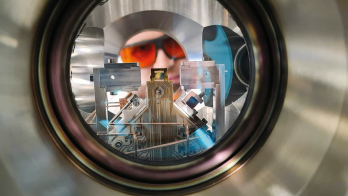
The first phase of the impressive Computing Grid project for CERN’s future Large Hadron Collider (LHC) was approved at a special meeting of CERN’s Council, its governing body, on 20 September.
CERN is gearing up for an unprecedented avalanche of data from the large experiments at the LHC (CERN Courier October p31). After LHC commissioning in 2006, the collider’s four giant detectors will be accumulating more than 10 million Gbytes of particle-collision data each year (equivalent to the contents of about 20 million CD-ROMs). To handle this will require a thousand times as much computing power than is available to CERN today.
Nearly 10,000 scientists, at hundreds of universities round the world, will group in virtual communities to analyse this LHC data. The strategy relies on the coordinated deployment of communications technologies at hundreds of institutes via an intricately interconnected worldwide grid of tens of thousands of computers and storage devices.
The LHC Computing Grid project will proceed in two phases. The first, to be activated in 2002 and continuing in 2003 and 2004, will develop the prototype equipment and techniques necessary for the data-intensive scientific computing of the LHC era. In 2005, 2006 and 2007, Phase 2 of the project, which will build on the experience gained in the first phase, will construct the production version of the LHC Computing Grid.
Phase 1 will require an investment at CERN of SwFr 30 million (some EURO 20 million) which will come from contributions from CERN’s member states and major involvement of industrial sponsors. More than 50 positions for young professionals will be created. Significant investments are also being made by participants in the LHC programme, particularly in the US and Japan, as well as Europe.
This challenge of handling huge quantities of data now being confronted by CERN will be faced subsequently by governments, commerce and other organizations. The LHC will be a computing testbed for the world.
Openlab attracts big names
To push the LHC computing effort, CERN has set up the openlab for DataGrid applications. Already, three leading information technology firms – Enterasys Networks, Intel and KPNQwest – are collaborating on this project in advanced distributed computing. Each firm will invest SwFr 2.5 million (EURO 1.6 million) over three years.
CERN already coordinates one major Grid computing effort – the EU-funded DataGrid project (CERN Courier March p5). An important aim of the CERN openlab is to take the results of these projects and apply them in the LHC Computing Grid.
The World Wide Web, which was developed at CERN during the run-up to research at the LEP collider, allows easy access to previously prepared information. Grid technologies will go further, searching out and analysing data from tens of thousands of interconnected computers and storage devices across the world.
This new capability will enable data stored anywhere to be exploited much more efficiently. Particle physics is blazing a scientific Grid trail for meteorologists, biologists and medical researchers.








